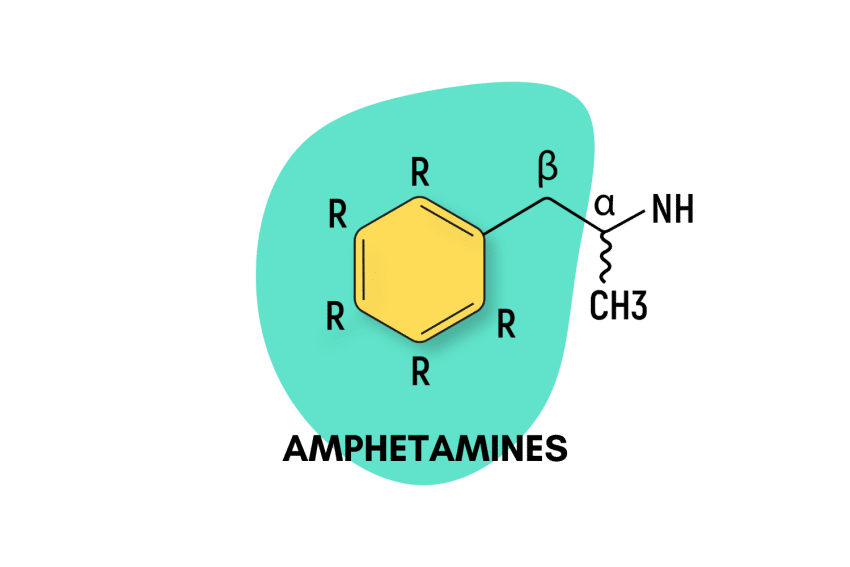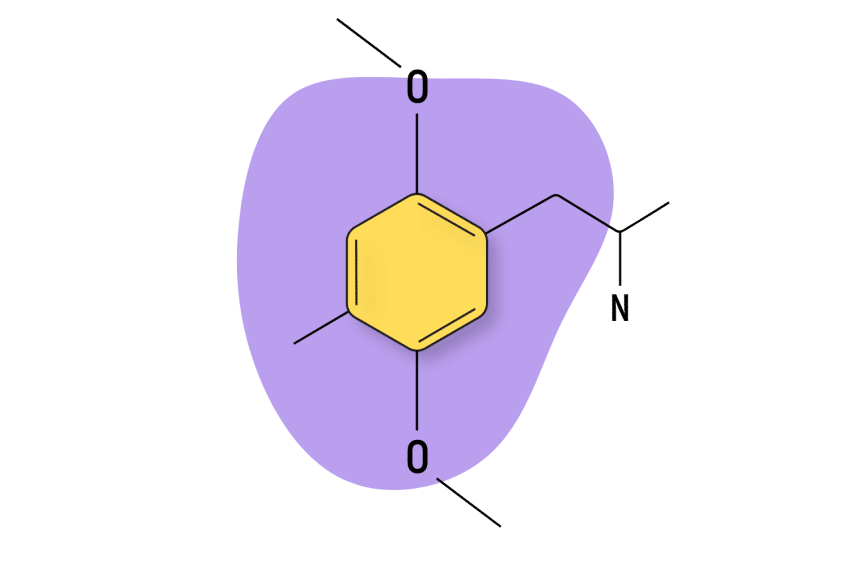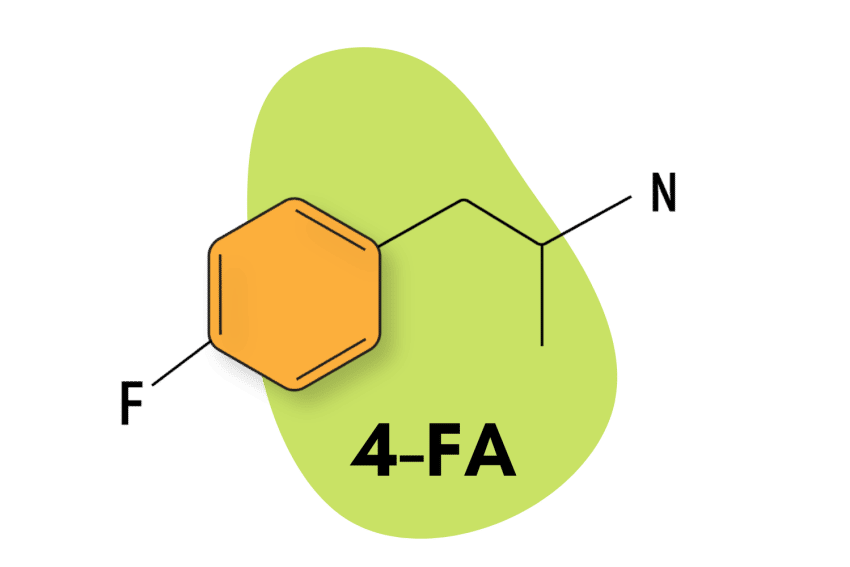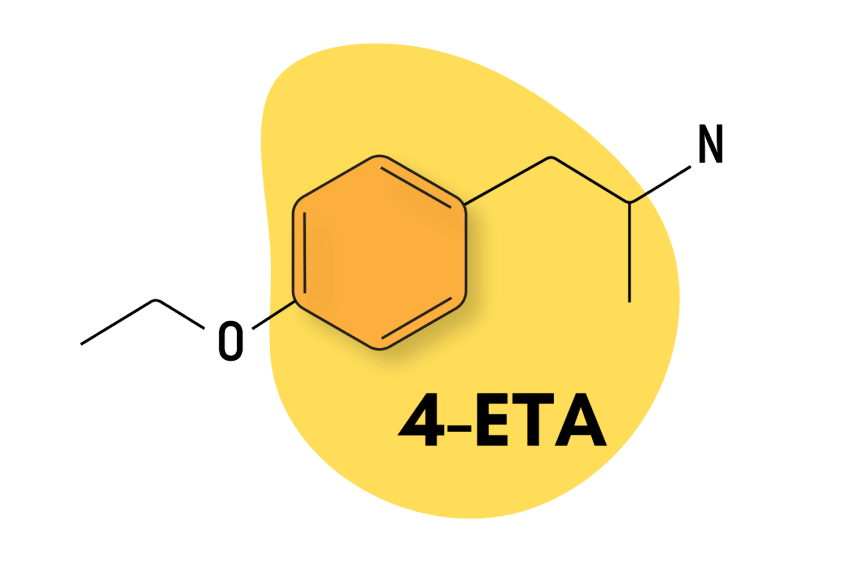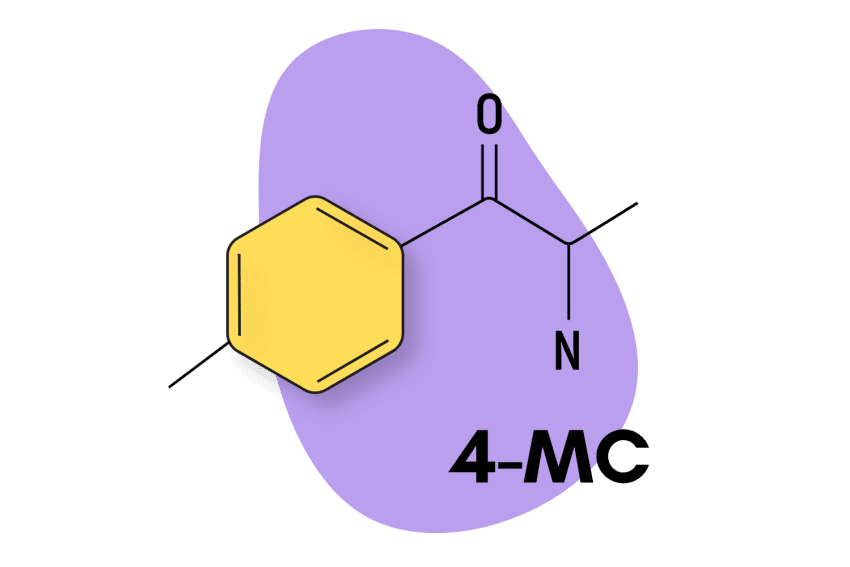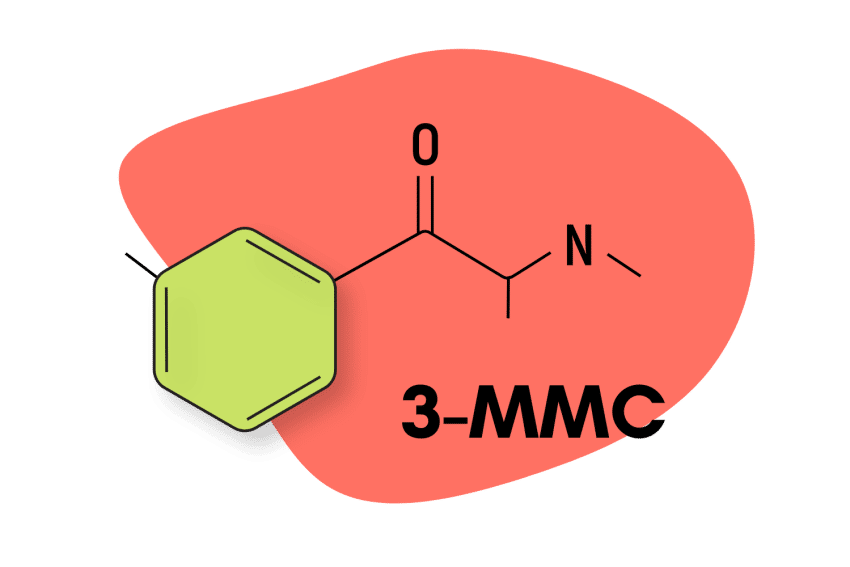2-FA (2-Fluoroamphetamine): Research Chemical Analysis
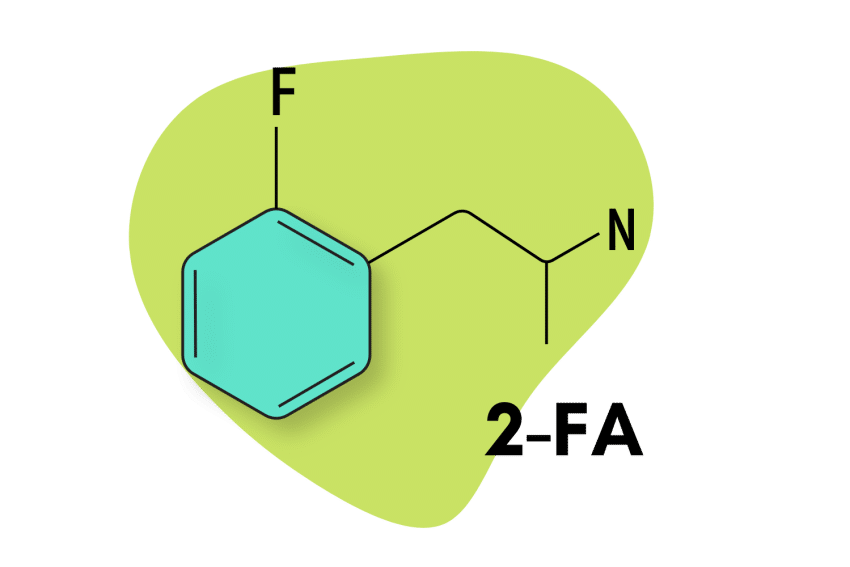
2-FA, also known as 2-Fluoroamphetamine, is a stimulant drug belonging to the amphetamine family and, more specifically, the fluorinated amphetamine subclass. This subtype is part of a large number of clandestinely produced amphetamine analogs appearing in the designer drug world in the past decade.
Along with its structural isomers — 3-Fluoroamphetamine (3-FA) and 4-Fluoroamphetamine (4-FA) — 2-FA does not appear to hold a high level of popularity compared to the dozens of designer amphetamines available.
As such, research on the pharmacology, subjective effects, and toxicity of 2-FA is scant.
2-FA is considered to be a structural analog of amphetamine and is presumed to possess a similar mechanism of action. Structurally, 2-FA – as well as 2-FMA and 2-FEA – houses the fluoride group a the 2-position.
2-FA Specs & Technical Details
| Chemical Name | 2-Fluoroamphetamine |
| Level of Risk | Low to Moderate |
| Street Names | 2-FA |
| Most Common Side Effects | Overstimulation, Disorganized thoughts, Anxiety |
| Duration of Effects | One to two hours |
| Legality | Controlled Substance |
| Status | Research Chemical |
| Estimated Threshold Dose | 5 mg |
| Common Dose | 20 – 30 mg |
| PubChem ID | 20027466 |
| CAS# | 3823-29-8 |
What Are Fluorinated Amphetamines?
Fluorinated amphetamines first started appearing on the market around 2010. Structurally, these compounds are defined by the presence of a fluoride group attached to the central ring moiety of the base amphetamine molecule.
In terms of how vastly it can affect a number of factors, such as pharmacology and bioavailability, the addition of this fluoride group is significant and also quite unpredictable.
Unfortunately, there’s little peer-reviewed research to be found on fluorinated amphetamines, although we do know some things.

In general, this subtype displays a strong affinity for dopamine and norepinephrine-releasing agents as opposed to serotonin. This means the effects of fluorinated amphetamine lean strongly towards the stimulant side and away from empathogenic and psychedelic properties.
When compared to other amphetamine subtypes, fluorinated amphetamines appear to have roughly average potency. As demonstrated by their threshold doses, fluorinated amphetamines appear to be only slightly less potent than DOX compounds but considerably more potent than MDXX compounds like MDMA.
It’s important to note that fluorinated substances have been found to release radioactive fluoride atoms into the brain, which can cause long-term cognitive problems. As such, there’s always a baseline risk level associated with these substances.
Trip Sitter Safe 2-FA Guidelines
- 🐍 I understand why psychostimulants should be treated with respect
- ⚖️ I’m familiar with the laws for 2-FA in my country & state
- 🍄 I’m familiar with and confident in the dose I’m taking
- 🧪 I’ve tested a sample of the substance I’m using with a drug-testing kit
- 💊 I’m not mixing any medications or other substances with 2-FA
- 🏔 I’m in a safe & comfortable environment with people I trust
- 🐺 One of the members of my group is responsible and sober (AKA a trip sitter)
- ⏳ I have nothing important scheduled for after the trip
- 🧠 I’m in a sound & healthy state of mind
- ❤️ I don’t have any underlying health issues — don’t take 2-FA if you have underlying heart, neurological, or psychiatric disorders
- 👭 Use the buddy system — 2-FA can remove your inhibition and allow you to make unsafe decisions, always stay with people you trust, and never go out alone
What Does 2-FA Feel Like?
Subjective user assessments of 2-FA, the only available data on the drug’s effects, consistently report that 2-FA is a highly stimulant compound with similar effects to those of dextroamphetamine (Zenzedi). In relation to its subtype, 2-FA seems to be the most stimulant-heavy, which shows how the addition of a fluoro group can have unpredictable effects. A structural isomer, 4-FA, for example, has a more empathogenic profile and is thus quite different from 2-FA.
As its purported similarity to dextroamphetamine suggests, online forums often report that 2-FA is a functional and effective substance for increasing productivity. However, when the dose is sufficiently increased, the effects begin to become more euphoric and overstimulating and are thus not suited to enhancing productivity or attention.

2-FA is associated with the following effects:
- Physical effects —Physical euphoria, pupil dilation, Stimulation, Stamina enhancement, Appetite suppression, Abnormal heartbeat, Constipation or Diarrhea, Dehydration, Difficulty urinating, Frequent urination, Headaches, Increased heart rate, Increased perspiration, Increased blood pressure, Muscle contractions, Muscle cramps, Muscle spasms, Seizure, Stomach cramps, Temporary erectile dysfunction, Temperature regulation suppression, Teeth grinding, Vasoconstriction, Tactile enhancement, Tactile hallucination
- Cognitive effects — Analysis enhancement, anxiety or anxiety suppression, Cognitive euphoria, Compulsive redosing, Delusion, Disinhibition, Ego inflation, Emotion suppression, Focus enhancement, Increased libido, Increased music appreciation, Motivation enhancement, Paranoia, Thought acceleration, Thought organization or disorganization, Wakefulness, Time distortion
- After Effects — Anxiety, Cognitive fatigue, Depersonalization, Depression, Feelings of impending doom, Irritability, Motivation suppression, Thought deceleration, Wakefulness
The effects of 2-FA are often described as smooth and subtle at low to moderate doses, as well as having minimal side effects and a gentle “comedown.”
What’s The Dose of 2-FA?
The oral dosing range for 2-FA breaks down as follows:
| Light | 5 – 15 mg |
| Common | 15 – 30 mg |
| Strong | 30 – 50 mg |
| Heavy | 50+ mg |
How Long Does 2-FA Last?
According to self-assessment reports, the duration of effects for 2-FA when taken orally is approximately three hours with around two hours of after-effects. When consumed through insufflation (snorting), the duration accelerates considerably to one hour of effects with two hours of after-effects.
Experimenting with different methods of administration in order to maximize both long and short-term effects is a common practice with psychostimulants. The pharmacokinetic values of compounds that have received more attention from researchers usually give scientific backing to this practice. However, we suggest caution when attempting multiple methods of administration. Multiple doses contribute to a bigger risk of acute intoxication.
Is 2-FA Safe?
A general lack of studies on 2-FA forces us to determine its safety profile through a series of educated assumptions based on subjective reports.
The threshold dose of 2-FA (5 mg) is of considerable potency, which would normally indicate risk in terms of acute intoxication. Users often report that it is easy to overshoot your intended dose on 2-FA, but, at the same time, they also talk about a “ceiling dose,” which means that, after a certain point, the effects of 2-FA seem to stagnate. This has yet to be demonstrated scientifically but, if true, would lower the abuse potential of 2-FA.

Due to its stimulant nature, we can also assume that 2-FA carries some of the same risks as a compound like cocaine. This often includes cardiac arrest, tachycardia, and other heart-related conditions.
As a class, fluorinated amphetamines are also known to produce neurotoxic metabolites. Information on drug forums suggests that 2-FA produces fewer of these metabolites in comparison to its analogs.
2-FA Adulteration
Common 2-FA Adulterants Include:
- Caffeine
- Cocaine
- DXM
- Fentanyl (very dangerous)
- Ketamine
- MDA
- Magnesium citrate or magnesium stearate (inert)
- Methamphetamines
- PMA/PMMA (very dangerous)
- Synthetic cathinone (bath salts)
2-FA Drug Interactions
Potent pharmacological compounds like 2-FA have a high risk of interacting with other substances or medications.
There are three main ways drugs can interact with each other in the body:
- Agonistic interactions — These are drugs that have a similar set of effects. When combined, their effects become stronger and can lead to side effects.
- Antagonistic interactions — These are drugs that have conflicting effects and may counteract each other. If medications are counteracted, they may lose their effectiveness in treating medical conditions.
- Liver metabolism interactions — The liver metabolizes virtually all substances that enter the body. If two or more drugs require the same enzymes, the rate of metabolism can slow down, causing both drugs to build up in the system.

1. Psychiatric Medications
One of the key mechanisms of 2-FA is an increase in both norepinephrine and dopamine activity in the brain. Therefore, mixing 2-FA with other drugs that alter serotonin or dopamine levels in the brain could bring on an agonistic interaction and, therefore, increased side effects.
An example of substances that affect serotonin and dopamine include monoamine oxidase inhibitors (MAOIs), selective serotonin reuptake inhibitors (SSRIs), serotonin and norepinephrine reuptake inhibitors (SNRIs), tricyclic antidepressants, and many others.
2. Heart Medications
2-FA is a stimulant which means it has the potential to induce an agonistic interaction with heart medication that increases heart rate and blood pressure. The resulting effect has the potential to overwhelm the user and result in a serious cardiac event. You should never take 2-FA if you’re using heart medications of any kind or have underlying heart disease.
3. Stimulant Medications
The strong stimulant action of 2-FA means that any additional stimulant compounds could result in a potent agonistic interaction and a consequential acute intoxication. Do not take stimulant medications such as ADHD when using 2-FA, and try to stay away from lesser stimulants like coffee or nicotine.
Combining multiple stimulants could increase the chances of side effects like rapid heartbeat, high blood pressure, anxiety, or increased chances of heart attack or stroke.
4. Liver Metabolic Interactions
We do not have precise data on the metabolic pathway of 2-FA, but there is a high probability that, whatever pathway is taken, the CYP enzyme system will be involved. This means that drugs or foodstuffs that interact with CYP enzymes have the potential to disrupt the clearance of 2-FA. Depending on whether there is inhibition or induction, this will result in either increased side effects or decreased drug efficacy, respectively.
Is 2-FA Addictive?
We do not have solid data on how fluorinated amphetamines compare to other subtypes in terms of their addiction liability, nor how the individual members of the class stack up against each other.

However, the amphetamine-like nature of 2-FA, along with self-assessment reports, is enough to infer that 2-FA likely displays moderately addictive potential and the capability to cause psychological dependence.
Physical withdrawal effects are rare.
How Does 2-FA Work?
Psychostimulant compounds have been found to exert their effects through three main pathways:
- Some block the reuptake of neurotransmitters
- Some block the clearance of neurotransmitters
- Some reverse the polarity of neurotransmitter transporters
Although 2-FA has not been formally studied on the same level as traditional amphetamines, it is safe to assume that, just like other substituted amphetamines with substitutions at similar positions (with the notable exception of 4-FA), it most likely acts primarily as both a dopamine and norepinephrine releasing agent and does this by blocking the reuptake of these neurotransmitters.
But what exactly is the reuptake process, and how does it relate to dopamine and norepinephrine?
When neurotransmitters like dopamine and norepinephrine are released from the presynaptic neuron, they enter a space known as the synaptic cleft, which can be thought of as the space between neurons. In the synaptic cleft, neurotransmitters then look to bind to their particular receptors on another neuron, a process known as neurotransmission and how molecules like dopamine produce their effects.

“Reuptake” is one of the ways the body regulates the neurotransmission process. By utilizing what’s known as a “transport protein,” the body transports neurotransmitters out of the synaptic cleft and back into the presynaptic neuron, usually for breakdown. In this way, the levels of neurotransmitters in the synaptic cleft are reduced, which leads to less neurotransmission.
Consequently, compounds that can inhibit the actions of transporter proteins, like 2-FA, disrupt the reuptake process. This leads to a higher overall level of neurotransmitters in the synaptic cleft, translating into more neurotransmission and, thus, more of the pharmacological effects associated with said neurotransmitter.
Pharmacokinetics of 2-FA
Due to a lack of studies, the pharmacokinetic (PK) tendencies of fluorinated amphetamines are poorly understood. Apart from subjective user assessments as to the duration of effects of 2-FA, we have no data on factors such as elimination half-life, peak plasma concentration times, distribution, or absorption.

However, researchers do have a general understanding of how the addition of a fluoride group tends to alter bioavailability. Replacing a hydrogen atom with a fluorine atom in certain compounds facilitates passage through the blood–brain barrier, a common effect due to the corresponding increase in lipophilicity granted by this substitution.
As such, we can likely assume fluorinated amphetamines have an increased bioavailability, which would, in turn, increase their potency.
Final Thoughts on 2-FA
One user described 2-FA as “the kindest stimulant I have ever had. The easiest comedowns by far. Very functional with minimum side effects and anxiety”.
From what little information is available, the former description seems like the best summary of 2-FA’s characteristics.
The compound is a good option for those who are interested in an effective cognitive stimulant with a relatively small side effects profile.



